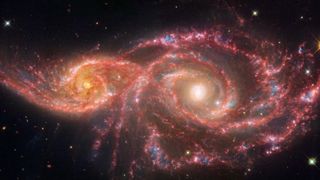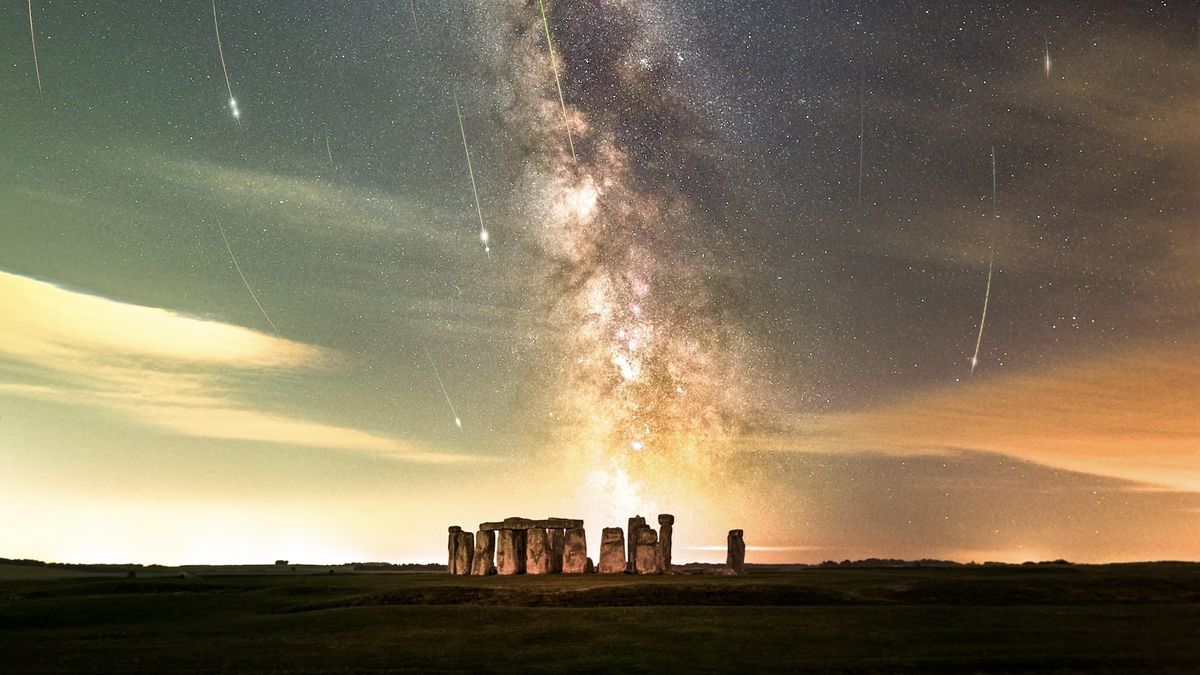You didn’t need a telescope to appreciate the cosmos in 2024. With stunning global auroras, prolific meteor showers and a total solar eclipse witnessed by tens of millions of people, space came to Earth in style this year.
But while many of us were stargazing, ambitious space exploration missions and astronomy campaigns looked far beyond Earth’s atmosphere. From sublime views of deep space to intimate portraits of orbital debris, here are our favorite space photos of the year — and what made them so special.
Nose to the grindstone
On Jan. 19, Japan’s Japan Aerospace Exploration Agency (JAXA) made history when its Smart Lander for Investigating Moon (SLIM) spacecraft reached the lunar surface. The mission was Japan’s first successful moon landing and the most precise lunar touchdown in history, with the spacecraft (nicknamed “Moon Sniper”) landing approximately 10 meters (33 feet) from its target point. There was one little problem: SLIM landed on its face, rather than on its feet. Despite this hiccup, the lander survived three freezing lunar nights in a row before finally losing contact with Earth in April. A small accompanying robot, named Sora-Q, ejected from the lander as it descended and later took this stunning shot of the stricken lander.
Blood-red eyes

Sometimes, when a space telescope gazes into the void, the void gazes back. That was the case in an eerie image of the colliding galaxies IC 2163 (left) and NGC 2207 (right), as seen by the Hubble and James Webb space telescopes. Because Webb specializes in detecting infrared wavelengths, the composite image takes on an ominous, bloodshot hue. These canoodling galaxies are active star factories that will one day merge into a single giant structure; until then, the bright cores of the galaxies appear like watchful eyes in the dark.
Related: 42 jaw-dropping James Webb Space Telescope images
A selfie with Earth
On Feb. 15, Houston-based Intuitive Machines launched an ambitious mission to the moon starring a robotic lander named Odysseus (or “Odie,” for short). On Feb. 22, Odie successfully touched down near the lunar south pole, becoming the first private spacecraft to ever reach the moon, and the first U.S.-made spacecraft to land there in more than 50 years. On its way, Odie couldn’t help but snap a celebratory selfie from orbit with our blue planet in the background.
Alien lake of fire
Jupiter’s moon Io is the most volcanically active world in the solar system, with hundreds of lava-spewing mountains dotting its surface. Earlier this year, NASA’s Juno spacecraft captured the closest view of Io in decades when it swooped within 930 miles (1,500 kilometers) of the volcanic moon’s surface. Along with an incredibly detailed global view of the moon, Juno also captured this closeup of Loki Patera — a 127-mile-long (200 km) lava lake on Io’s surface. The image revealed a raft of cooling lava at the lake’s center, ringed by possibly molten magma around its edges.
Grasping for answers
In May, NASA scientists revealed a stunning new image of a strange object located 1,300 light-years away in the constellation Puppis (the “poop deck”). Nicknamed “God’s hand” for its ethereal glow and impressive reach, the structure is a cometary globule — a massive, star-forming cloud of gas with a comet-like trail dragging behind it. Nobody knows precisely how these mysterious structures form, but it’s likely that they are sculpted by the radiation from hot, young stars or nearby supernova explosions. The image was captured with the Dark Energy Camera (DECam) on the Blanco Telescope in Chile.
A shower at Stonehenge
In August, one of the oldest astronomical monuments in the world took center stage during one of the year’s biggest showers of “shooting stars.” Snapped by U.K.-based astrophotographer Josh Dury, the composite image shows the Perseid meteor shower falling above Stonehenge, the famous stone structure in Wiltshire, England that was built to align with the sun during the summer solstice roughly 5,000 years ago. Dury combined 43 individual exposures to get the stunning final product.
Taming ‘the behemoth’
Squint, and it looks like a lopsided eyeball in space. But it’s actually something far more impressive: The first zoomed-in image of an individual star outside our galaxy ever taken. The star, known as WOH G64 — or “the behemoth star” for its impressive size (more than 1,500 times wider than our sun) — is located 160,000 light-years from Earth in the Large Magellanic Cloud, a satellite galaxy that orbits the Milky Way. Researchers captured the groundbreaking image using the European Southern Observatory’s (ESO) Very Large Telescope Interferometer (VLTI) in Chile. The new observations reveal that the massive star may be on the verge of dying in a supernova explosion.
The sun belches pink
On April 8, the shadow of the moon raced across North America during a rare total solar eclipse that was visible to an estimated 44 million people. Eclipse gazers who looked close with stargazing binoculars or a solar telescope may have seen towering, pink flame-like structures billowing out of our star’s edge. These looming structures are called solar prominences — huge, looping tendrils of plasma that leap out of the sun’s surface and stand anchored there for weeks or months at a time, according to NASA. The prominences look pink in this photo, taken by NASA astrophotographer Keegan Barber, thanks to the sun’s hydrogen, which emits reddish light at high temperatures. The dark face of the moon looms in the foreground.
Cozying up with space junk
It may look like a still life — but this image was captured at thousands of miles per hour. Snapped in low Earth orbit by private space company Astroscale, the unprecedented image is the first close-up photo of an individual piece of space debris ever taken. It shows the spent upper stage of a Japanese H-IIA rocket that has been circling Earth since 2009 — an object that could pose danger to astronauts and spacecraft if it were to collide with any of the thousands of pieces of orbital debris clogging up our upper atmosphere. Now that Astroscale knows it can get its spacecraft close to a piece of debris without crashing, the company will, in a future mission, attempt to remove a piece of space junk from orbit using a robotic arm.
Man takes walk
In September, billionaire and private astronaut Jared Isaacman bought his way into one of the most iconic space photos of the year. Emerging partway from a SpaceX Crew Dragon capsule in low Earth orbit, Isaacman tested out a new SpaceX spacesuit for about 10 minutes while our planet turned slowly below him. This glorious photo-op — the first commercial spacewalk in history — was the crowning moment of the Polaris Dawn project, a private space mission funded by Isaacman in partnership with SpaceX.
Want more sublime space images? Follow along every Sunday with our Space Photo of The Week column.
